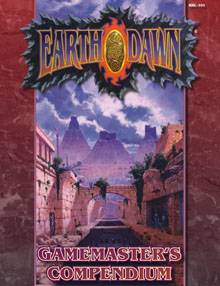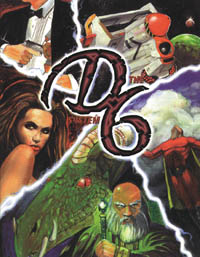
Earthdawn is a fantasy role-playing game, originally produced by FASA in 1993. In 1999 it was licensed to Living Room Games, which produced the Second Edition. It was licensed to RedBrick in 2003, who released the Classic Edition in 2005 and the game's Third Edition in 2009. The license is now held by FASA Games, Inc., who have released the Fourth Edition, with updated mechanics and an advanced metaplot timeline. Vagrant Workshop released the Age of Legend edition in 2016 using alternative rules-lite mechanics.

The Generic Universal Role Playing System, or GURPS, is a tabletop role-playing game system published by Steve Jackson Games. The system is designed to run any genre using the same core mechanics. The core rules were first written by Steve Jackson and published in 1986, at a time when most such systems were story- or genre-specific. Since then, four editions have been published. The current line editor is Sean Punch.
The Storytelling System is a role-playing game system created by White Wolf, Inc. for the Chronicles of Darkness, a game world with several tabletop role-playing games tied in. The Storytelling System is largely based on the Storyteller System, the rule set used for White Wolf's older game setting, the World of Darkness.

Fuzion is a generic role-playing game system created by the collaboration of R. Talsorian Games and Hero Games. The rights to Fuzion are jointly held by Mike Pondsmith of R. Talsorian Games, along with Steve Peterson and Ray Greer of Hero Games. Fuzion is a combination of the Interlock System,, and the HERO system. Fuzion is an adaptable system which can be played in any genre and setting imaginable.

HoL is a role-playing game created by Dirt Merchant Games and produced by Black Dog Game Factory, a subsidiary of White Wolf which produced adult oriented RPGs. The HoL Core Rulebook was published in 1994, and was followed up by one other supplement Buttery Wholesomeness in 1995. Although HoL is playable, it was meant as a satire of RPGs. The pages of the books are written by hand, and the authors freely take stabs at other popular role-playing games, particularly Vampire: The Masquerade and Dungeons & Dragons, and those who play them.

Savage Worlds is a role-playing game written by Shane Lacy Hensley and published by Pinnacle Entertainment Group. The game emphasizes speed of play and reduced preparation over realism or detail. The game received the 2003 Origin Gamers' Choice Award for best role-playing game.

The D6 System is a role-playing game system published by West End Games (WEG) and licensees. While the system is primarily intended for pen-and-paper role-playing games, variations of the system have also been used in live action role-playing games and miniature battle games. The system is named after the six-sided die, which is used in every roll required by the system.
Magic systems in games are the rules, limitations, abilities, and characteristics that define magic in a game.

Role-playing games (RPGs) have developed specialized terminology. This includes both terminology used within RPGs to describe in-game concepts and terminology used to describe RPGs. Role-playing games also have specialized slang and jargon associated with them.
In the Dungeons & Dragons role-playing game, game mechanics and dice rolls determine much of what happens. These mechanics include:

Character creation is the process of defining a player character in a role-playing game. The result of character creation is a direct characterization that is recorded on a character sheet. This may include a representation of the character's physical, mental, psychological, and social attributes and skills in terms of the specific game's mechanics. It may also include informal descriptions of the character's physical appearance, personality, personal back-story ("background"), and possessions. Games with a fantasy setting may include traits such as race, class, or species. Character creation is the first step taken by the players in preparation for a game.
Dice notation is a system to represent different combinations of dice in wargames and tabletop role-playing games using simple algebra-like notation such as d8+2.

Ghostbusters, subtitled "A Frightfully Cheerful Roleplaying Game", is a comedy role-playing game published by West End Games (WEG) in 1986 that is based on the 1984 film Ghostbusters.
The One-Roll Engine is a generic role-playing game system developed by Greg Stolze for the alternate history superhero roleplaying game Godlike. The system was expanded upon in the modern-day sequel, Wild Talents, as well as the demonic supervillain game Better Angels, the Film Noir game A Dirty World, the heroic fantasy game Reign, and the free horror game Nemesis. A simpler version was used for Monsters and Other Childish Things. The One-Roll Engine is notable for its unique dice rolling system in which matched values on ten-sided dice (d10s) determine all variables of a check in a single roll. This eliminates, for example, the separate initiative, hit location and damage rolls common during combat in other systems.
Witch Hunter: The Invisible World is an American ENnies-nominated swashbuckling, colonial, horror role-playing game. It was first published by Paradigm Concepts in 2007 and premiered at the Origins Game Fair. The players play witch hunters, otherwise-normal men and women who have left their past behind in order to seek and destroy supernatural evil. Major contributors to Witch Hunter are: Scott Charlton, Pat Laboyko, Rucht Lilavivat, Henry Lopez, M. Sean Molley, Brian Schoner, Robert J. Schwalb, Robert Vaughn, and Eric Wiener.

QAGS is a generic tabletop roleplaying game. Setting for this system have varied and ranged widely.
The Star Wars Roleplaying Game is a tabletop role-playing game set in the Star Wars universe, first published by Fantasy Flight Games in 2012. It consists of different standalone cross-compatible games where each one is a separate themed experience. The sourcebooks support games set from the Clone Wars era to the original Star Wars trilogy era; there is limited support for the Star Wars sequel trilogy era. Since 2020, the game line has been maintained by Asmodee's subsidiary Edge Studio.
The Cortex Plus System is a toolkit RPG system that evolved from Margaret Weis Productions, Ltd's Cortex System. It has been used for four published games and one published preview to date, and the design principles are in the Cortex Plus Hacker's Guide, a book of advice in how to create new games using Cortex Plus, and list of new games produced via Kickstarter. According to the Hacker's Guide there are three basic 'flavors' of Cortex Plus; Action, Drama, and Heroic.

Shadowrun is a science fantasy tabletop role-playing game set in an alternate future in which cybernetics, magic and fantasy creatures co-exist. It combines genres of cyberpunk, urban fantasy, and crime, with occasional elements of conspiracy, horror, and detective fiction. From its inception in 1989, it has spawned a franchise that includes a series of novels, a collectible card game, two miniature-based tabletop wargames, and multiple video games.

Don't Look Back: Terror is Never Far Behind (DLB) is a supernatural and paranormal horror-themed role-playing game set in modern times that was initially published in 1994 by Mind Ventures. The player characters investigate supernatural and paranormal events for a secret government agency. A more light-hearted second edition was published in 1995. The game received positive reviews in game periodicals including Dragon and Arcane.











